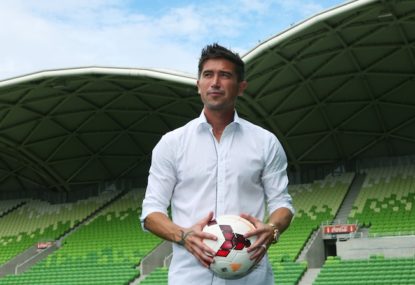At the date of writing this, it is November the 29. That is 18 years to the day since one of the greatest disasters – and travesties – in the Socceroos’ storied history.
No-one wants to remember it, but it is unlikely those who were involved, or who watched it, will ever forget it.
It is, of course, the night the Socceroos should have booked their place in the 1998 World Cup finals in France, except for an improbable 2-2 draw against Iran at a soldout MCG.
Many of the players who donned the gold shirt that night have never watched a replay of the game. It would prove to be the last chance at a World Cup finals run for such players as Graham Arnold, Robbie Slater, Ned Zelic, Mark Bosnich, Alex Tobin and Aurelio Vidmar.
It was a night that Australian football came of age, as the Socceroos utterly dominated their opponents with some of the most scintillating attacking football the national team had ever produced.
If that sounds like a contra-indicative statement, it’s worth considering the circumstances at the time.
David Hill was running Soccer Australia and he had a definite vision for the National Soccer League which included broad-based support clubs such as Northern Spirit and Perth Glory. Hill also identified that the local game would benefit enormously from a successful Socceroos side and so convinced the board to shell out some sizeable coin to lure Terry Venables to coach the national team.
Venables was a roguish character and an undeniably successful coach at club and national level and was to that point the biggest name to take the helm of the Australian team. His previous appointment had been with the English national team.
Under Venables, the Socceroos became a fluid attacking unit and his record was perfect leading into the two-legged play-off against Iran. Played 12, won 12, goals scored 42, goals conceded four.
In the first leg, played in Tehran’s Azadi Stadium in front of 128,000 fans, the Socceroos drew 1-1, courtesy of a Harry Kewell goal. It set up the second leg nicely.
Hill’s plan seemed to be falling into place. Melbourne was abuzz with a big event atmosphere and the national federation had organised a reunion of the 1974 Socceroos – at that time the only side to have played in the World Cup finals. Fans poured into Melbourne from all over the country. Ansett (remember them?) had put on extra flights from Sydney and Brisbane to cope with the demand.
Within two minutes of kick-off, Mark Viduka had hit the crossbar, Aurelio Vidmar had a shot cleared off the line and then hit the post from the resulting corner. Vidmar could have had a hat-trick inside the first quarter-hour.
Iran, who had lost three and drawn three of their last six qualifiers, looked like an over-matched cage fighter getting slaughtered from every conceivable angle. When Kewell scored from the Socceroos’ 12th strike on target, the MCG exploded. It should have been 6-0 at half-time.
The second half was simply more of the same. Iran had not had a shot on goal, they had hardly played a ball into the Socceroos’ penalty area. Barely 10 minutes had elapsed when Aurelio Vidmar followed up a Craig Foster shot that had hit the crossbar and swept the rebound home. In the stands, strangers became friends, fans dreamt of croissants and café au lait and Australia’s 24-year absence from the World Cup finals was all but over.
No one, not Venables, not any player, not any one of the 85,000 fans in attendance, not even Iran coach Valdier Viera, could to this day explain or comprehend what happened next.
As the Socceroos celebrated like it was, well, 1998, an infamous serial pest called Peter Hoare eluded security and ran onto the pitch, jumping on the back of the Iranian net and pulling it from the stanchions. The game was delayed for 12 minutes and when it resumed, it seemed like nothing had changed as the Socceroos’ gold brigade continued to besiege the Iranian’s now-sagging net.
The visitors registered their first shot on target in the 68th minute. Two minutes later they scored a streaky goal when Asian Player of the Year Khodadad Azizi played a ball from a blatantly offside position back to midfielder Karim Bagheri, who scored.
Another two minutes after that, Azizi this time beat a blatantly suspect offside trap and slid the ball past Bosnich, who up to the 70th minute might as well have watched the game from a corporate box.
It was a stunning four minutes. The crowd couldn’t quite believe what had happened. Venables would later be criticised for not closing the game down at 2-0 but in reality, it should have been 8-0 by then, and a third goal would have utterly finished off the Iranians.
Instead, the Socceroos continued to attack, Iran’s goal continued to lead a charmed life, and even as deep as the 10th minute of injury time, Graham Arnold had two shots saved by defender and keeper.
And then, at 10.12pm, which somewhat spookily is the exact time I am typing this, the referee’s whistle signalled the end of the game and the beginning of a funeral possession attended by 85,000 people.
People filed out of the famous arena and walked into the city centre, too stunned to speak. It was without a doubt the most one-sided draw in Socceroos history and Australia were eliminated without losing a game. They, along with eventual champions and host nation France, were the only two countries to not lose during the qualifying and finals stages of the 1998 World Cup.
It would take eight years to repair the damage from that night. But it is a night that should not be ignored for it forms an important part of our football history.
Where David Hill and Terry Venables gambled and lost, Frank Lowy and Guus Hiddink rolled the dice and won. History can be cruel.





























































































